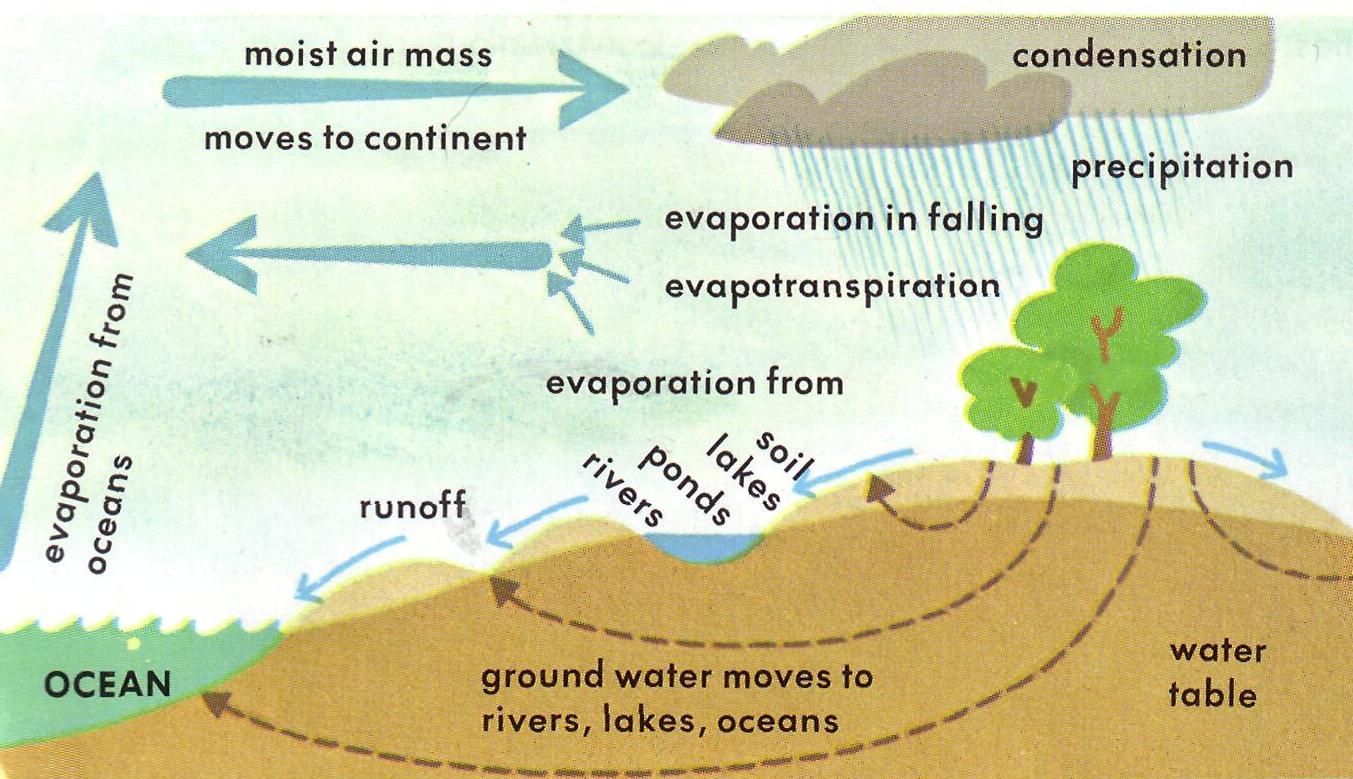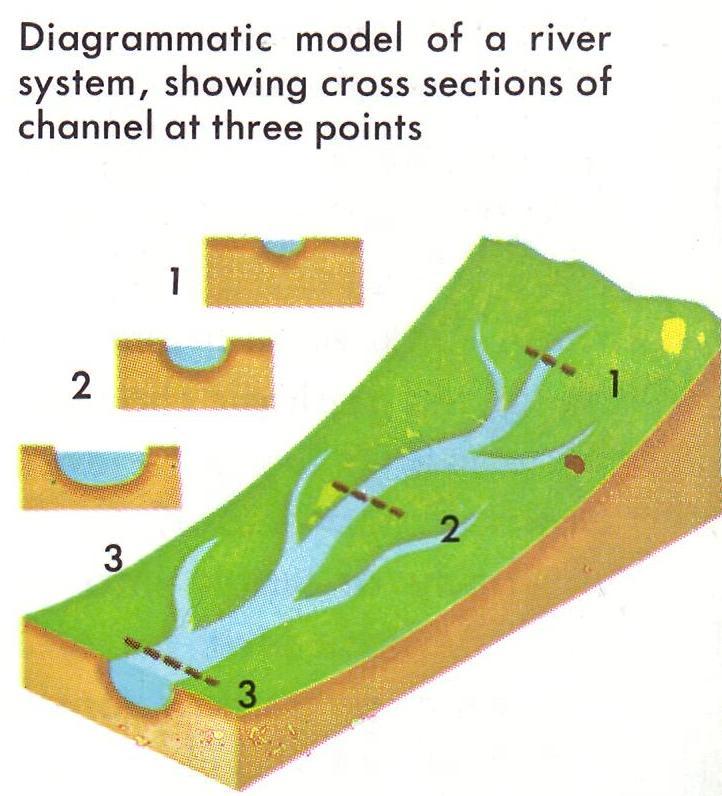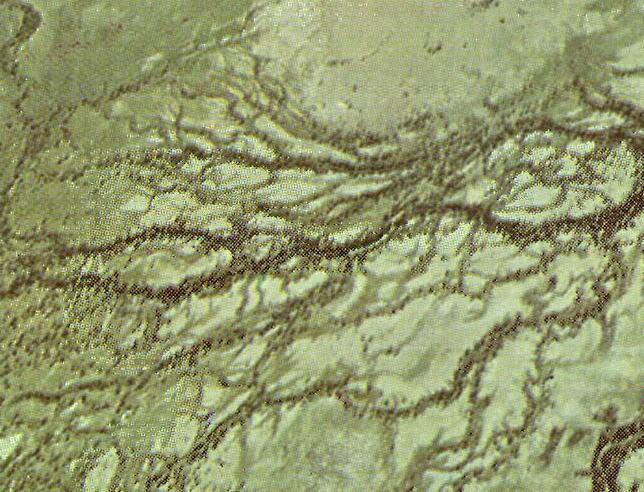
- •Part 1. Running Water
- •Vocabulary:
- •Running Water
- •The Hydrologic Cycle
- •The Form of Rivers
- •Dendritic Drainage Pattern
- •Part 2. River Profiles
- •Vocabulary:
- •River Profiles
- •1. Graded Profile 2. Smoother Steep Profile 3. Irregular Profile
- •Part 3. The Amazon River
- •Vocabulary:
- •Amazon River
- •Drainage Area
- •Origins
- •Flooding
- •Geography
- •1. What is anabranchs?
- •Tidal Bore (pororoca)
Running Water
 Running
water is the most powerful agent of erosion. Wind, glaciers, and
ocean waves are all confined to relatively limited land areas, but
running water acts almost everywhere, even in deserts. One fourth of
the 35,000 cubic miles of water falling on the continents each year
runs off into rivers, carrying away rock fragments with it. In the
United States, this erosion of the land surface takes place at an
average rate of about one inch in 750 years. Running water breaks
down the crust by the impact of rock debris it carries.
Running
water is the most powerful agent of erosion. Wind, glaciers, and
ocean waves are all confined to relatively limited land areas, but
running water acts almost everywhere, even in deserts. One fourth of
the 35,000 cubic miles of water falling on the continents each year
runs off into rivers, carrying away rock fragments with it. In the
United States, this erosion of the land surface takes place at an
average rate of about one inch in 750 years. Running water breaks
down the crust by the impact of rock debris it carries.
A single shower may involve the downpour of more than a billion tons of water. Each raindrop in the shower becomes important in erosion, especially in areas with sparse vegetation and unconsolidated sediments. Runoff water rarely travels far as a continuous sheet, for it is spoken up into rivulets and streams by surface irregularities in rock type and relief.
Running water carries its load of rock debris partly in suspension, partly by rolling and bouncing it along the Bottom, and partly in solution. The carrying power of a stream is proportional to the square of its velocity, and so is enormously increased in time of flood.
The Hydrologic Cycle
 The
Hydrologic Cycle is a continuous change in the state of water as it
passes through a cycle of evaporation, condensation, and
precipitation. Of the water that falls on the land, up to 90 percent
is evaporated. Some is absorbed by plants and subsequently
transpired to the atmosphere, some runs off in streams and rivers,
and some soaks into the ground. The relative amounts of water
following these paths vary considerably and depend upon the slope of
the ground; the character of the soil and rocks, -the amount, rate,
and distribution of rainfall; the amount and type of plant cover;
and the temperature. The hydrosphere is estimated to include over
300 million cubic miles of water, about 97 percent of which is in
the oceans.
The
Hydrologic Cycle is a continuous change in the state of water as it
passes through a cycle of evaporation, condensation, and
precipitation. Of the water that falls on the land, up to 90 percent
is evaporated. Some is absorbed by plants and subsequently
transpired to the atmosphere, some runs off in streams and rivers,
and some soaks into the ground. The relative amounts of water
following these paths vary considerably and depend upon the slope of
the ground; the character of the soil and rocks, -the amount, rate,
and distribution of rainfall; the amount and type of plant cover;
and the temperature. The hydrosphere is estimated to include over
300 million cubic miles of water, about 97 percent of which is in
the oceans.
The Form of Rivers
 The
form of Rivers depends upon many factors. Water runs downhill under
the influence of gravity, the flow of the water being
characteristically turbulent, with swirls and eddies. The overall
long profile of a river valley is concave upwards, however much its
gradient (its slope or fall in a given distance) may vary. The
velocity of the stream increases with the gradient, but also depends
on other factors, including the position within the river channel,
the degree of turbulence, the shape and course of the channel, and
the stream load (transported materials).
The
form of Rivers depends upon many factors. Water runs downhill under
the influence of gravity, the flow of the water being
characteristically turbulent, with swirls and eddies. The overall
long profile of a river valley is concave upwards, however much its
gradient (its slope or fall in a given distance) may vary. The
velocity of the stream increases with the gradient, but also depends
on other factors, including the position within the river channel,
the degree of turbulence, the shape and course of the channel, and
the stream load (transported materials).
Dendritic Drainage Pattern
Dendritic Drainage Pattern of Diamantina River, Queensland, Australia, is typical of river development in areas where the underlying rocks are relatively uniform in their resistance to erosion. This pattern may be modified by continued down-cutting of the river.
Statements:
1. The strongest force of erosion is running water.
2. There is no water in deserts.
3. Running water carry away rock fragments with it.
4. A billion tons of water may be dropped by a single shower.
5. Raindrops in the shower aren’t important in erosion.
6. Running water carries its load of rock debris only in suspension.
7. The carrying power of a stream is enormously increased in time of flood.
8. Water passes through a cycle of evaporation, condensation, and precipitation.
9. The hydrosphere is estimated to include over 400 million cubic miles of water, about 99 percent of which is in the oceans.
10. The velocity of the stream depends on the precipitation level.
11. The gradient of the river never varies.
12. Dendritic Drainage Pattern of Diamantina River, Queensland, Australia, is typical of river development in areas where the underlying rocks are relatively similar in their resistance to erosion.
